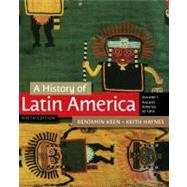- ISBN: 9781111841409 | 1111841403
- Cover: Paperback
- Copyright: 1/23/2012
The best-selling text for introductory Latin American history courses, A HISTORY OF LATIN AMERICA encompasses political and diplomatic theory, class structure and economic organization, culture and religion, and the environment. The integrating framework is the dependency theory, the most popular interpretation of Latin American history, which stresses the economic relationship of Latin American nations to wealthier nations, particularly the United States. Spanning pre-historic times to the present, A HISTORY OF LATIN AMERICA takes both a chronological and a nation-by-nation approach, and includes the most recent historical analysis and the most up-to-date scholarship. The Ninth Edition includes expanded coverage of social and cultural history (including music) throughout and increased attention to women, indigenous cultures, and Afro-Latino people assures well balanced coverage of the region's diverse histories.







